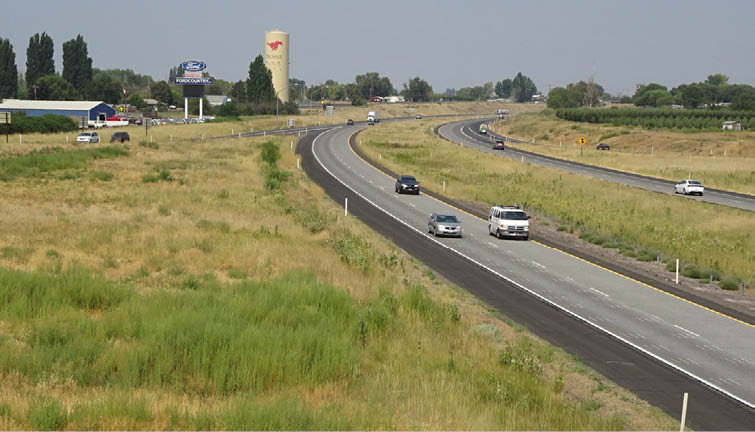ROADSIDE REVEGETATION
An Integrated Approach to Establishing Native Plants and Pollinator Habitat
8.3 Mapping and planning benefit Washington State pollinators
Washington State Department of Transportation (WSDOT) maintains about 100,000 acres of roadside. WSDOT has been implementing integrated vegetation management for many years with the overarching goal of reducing undesirable vegetation while encouraging desirable vegetation. Many of their practices and policies to manage vegetation also promote pollinator habitat.

This interchange, in the heart of Washington's grape and hops growing region, is undergoing integrated management to reduce the dominant invasive species kochia and cereal rye. Native milkweed occurs naturally at this site, serving as potential breeding habitat for monarch butterflies.
Photo credit: Washington State Department of Transportation
Whenever possible, WSDOT preserves existing native habitat that can provide food, host plants, shelter, and nesting for pollinators. WSDOT also identifies roadsides for "managed succession" (WSDOT 2003). These are areas that have desirable vegetation that could flourish under a strategy that allows natural plant succession to proceed to a stable plant community. Outside of the clear zone or lines of sight where repeated mowing still occurs, roadsides managed for natural succession have multi-year treatment strategies that employ a variety of vegetation management tools, including reduced mowing and targeted herbicide use. Managed succession allows native vegetation to emerge and flourish, with sagebrush (Artemisia tridentata), greasewood (Sarcobatus vermiculatus), and native grasses taking hold in prairie regions, and understory shrubs that are attractive to pollinators like snowberry (Symphoricarpos albus), Oregon grape (Mahonia nervosa), and spirea (Spiraea sp) in other regions.
When roadside revegetation is needed, WSDOT prioritizes the use of native plants, including a diversity of native wildflowers and flowering shrubs and trees. Landscape designers focus on native plants that can establish with minimal input and compete with weeds. Key considerations for pollinators during the planning process include sequential bloom periods of flowering plants and high plant diversity. Maintenance staff are included in the planning process to provide input on long-lived plants that can be managed minimally.
Mapping and planning are key elements of Washington DOT's approach to roadside revegetation and maintenance. Vegetation inventories help to identify areas with weed infestations as well as areas that are conducive to managed succession. All maintenance staff have tablets, used to record data and view maps and aerial images.

A site identified through GIS analysis as a priority location for managed succession to replace nonnative species with desirable native species. Careful planning and management for a number of years has increased native plants such as camas, snowberry, serviceberry, and Oregon grape, but invasive scotch broom still remains and requires selective treatment with herbicides.
Photo credit: Washington State Department of Transportation
WSDOT uses the best available science to inform their actions, and also undertake their own research to determine the right methods for their management needs. For example, experimental plots are used for testing seed mixes and planting methods. WSDOT also monitors the effectiveness of maintenance techniques on vegetation and pollinators. More information about the actions Washington Department of Transportation is taking to protect pollinators and promote pollinator health can be found at their website.

